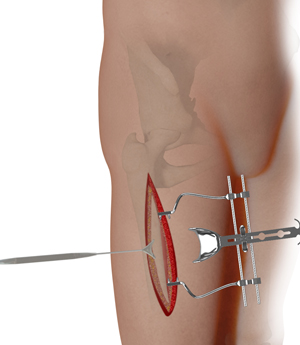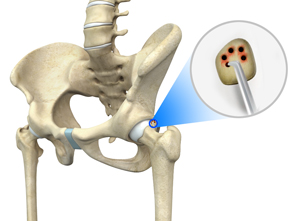-
Hip Replacement
Mini-Posterior Hip Replacement
Mini-posterior hip replacement is a surgical procedure used to replace your damaged hip with synthetic parts inserted through a small incision made at the back of the hip.
Know More -
Total Hip Replacement

Total hip replacement is a surgical procedure in which the damaged cartilage and bone are removed from the hip joint and replaced with artificial components. The main indication for total hip replacement is arthritis.
Know More -
Posterior Hip Replacement

Posterior hip replacement is a minimally invasive surgical procedure in which the worn out or damaged surfaces of the hip joint are removed and replaced with artificial joint components made of metal, ceramic, or plastic.
Know More -
Robotic Total Hip Replacement

Robotic total hip replacement is a minimally invasive procedure where your surgeon is assisted by a robotic system to perform a total hip replacement surgery.
Know More -
Minimally Invasive Total Hip Replacement

Minimally invasive total hip replacement is a surgical procedure performed through one or two small incisions rather than the single long incision of 10–12-inches as in the traditional approach.
Know More -
Anterior Hip Replacement

Anterior hip replacement surgery is performed under general anesthesia or regional anesthesia. You will lie down on your back, on a special operating table that enables your surgeon to perform the surgery from the front of the hip.
Know More -
Revision Hip Replacement

Revision hip replacement is a complex surgical procedure in which all or part of a previously implanted hip joint is replaced with a new artificial hip joint. Total hip replacement surgery is an option to relieve severe arthritis pain that limits your daily activities.
Know More -
Direct Superior Hip Replacement

Direct superior hip replacement is a minimally invasive surgery that provides your surgeon access to the hip joint with minimum displacement or damage to the surrounding muscles, tendons, and ligaments.
Know More -
Rapid Recovery Hip Replacement

Rapid recovery hip replacement is an innovative and minimally invasive surgical procedure to replace a damaged hip joint with a prosthesis. It is associated with minimal post-operative pain and discomfort and a shorter recovery time. The surgery can often be performed as an outpatient procedure.
Know More -
X-ray Guided Hip Replacement

X-ray guided hip replacement involves the use of pre-operative radiographic studies to help select the right size of the implant and to determine the proper position in which the implant should be placed.
Know More -
Robotic Anterior Total Hip Arthroplasty

Robotic anterior total hip arthroplasty is a minimally invasive surgical procedure that involves the use of a specialized robotic system to remove the damaged parts of a hip joint and replace them with an artificial prosthesis or implant from an anterior approach rather than a traditional total hip arthroplasty approach.
Know More -
Computer-assisted Hip Replacement

Computer-assisted hip replacement is an image-guided, minimally invasive surgical procedure to replace your diseased or damaged hip with an artificial device using the assistance of computer software. The system creates and displays images and provides information that aids your surgeon at various stages of the procedure to improve accuracy and results.
Know More -
Zimmer THA

Zimmer THA (total hip arthroplasty) is a hip replacement procedure in which the damaged or worn out articulating surfaces of the hip joint are removed and replaced with a state-of-the-art Zimmer hip prosthesis.
Know More -
Correction of a Loose Hip Replacement

Reoperation of a total hip replacement to resolve a painful hip condition and loss of motion due to a loosened prosthesis (artificial hip joint) is known as correction of a loose hip replacement.
Know More -
Outpatient Hip Replacement

Outpatient hip surgeries are mainly targeted at treating the joints damaged by arthritis and injuries. Chronic joint pain due to erosion of cartilage, damage due to accidents and autoimmune diseases, or bone death leading to the destruction of cartilage are also treated with the help of this surgery.
Know More -
Short-Stay and Fast-Track Hip Replacement

Short-stay and fast-track hip replacement is a minimally invasive surgical procedure in which worn-out or damaged surfaces of the hip joint are removed and replaced with prostheses. This method of treatment is known as a synchronized perioperative approach directed at decreasing surgical stress and promoting quicker postoperative recovery.
Know More -
Correction of a Failed Hip Replacement

Reoperation of a total hip replacement to resolve a painful hip condition arising out of a damaged or worn out prosthesis (artificial hip joint) is known as correction of a failed hip replacement.
Know More -
Computer-Navigated Total Hip Replacement

Computer navigation provides real-time imaging of the affected joint and surgical instruments during surgery. Data for the images are provided by infrared sensors fixed to the bones of the joint and the surgical instruments.
Know More -
Correction of a Painful Hip Replacement

Reoperation of a total hip replacement to resolve a painful hip condition arising out of a damaged or worn out prosthesis (artificial hip joint) is known as correction of a painful hip replacement.
Know More -
Outpatient Anterior Approach Hip Replacement

Outpatient anterior approach hip replacement refers to surgery accessed from in front of the hip in an outpatient setting. It is a minimally invasive procedure that has been developed to cause less muscle damage, faster recovery, and less disruption in a patient’s life.
Know More -
Hip Arthroscopy

Hip arthroscopy, also referred to as keyhole or minimally invasive surgery, is a procedure in which an arthroscope is inserted into your hip joint to check for any damage and repair it simultaneously.
Know More -
Revision Hip Surgery

Revision hip surgery is a repeat hip surgery performed in certain patients to correct the problems or complications of previous hip surgery and overcome its limitations.
Know More -
Complex Hip Reconstruction Surgery

Complex hip reconstruction surgery is a surgical procedure employed to treat hip structures with complex hip fractures or traumatic hip injuries, deformities, structural issues, and damage from diseases such as arthritis.
Know More -
Stryker Tripolar THA

Stryker Tripolar THA is a total hip replacement procedure using a special implant called an unconstrained tripolar implant or dual mobility acetabular component designed by Stryker. This implant was introduced to prevent instability caused by other types of implants.
Know More -
Iliopsoas Tendon Lengthening

Iliopsoas tendon lengthening is a procedure that involves the excision or cutting of the iliopsoas tendon in the hip to reduce pain and improve range of motion. The iliopsoas is the hip flexor tendon located over the front of the hip socket.
Know More -
Hip Surgery

Hip surgery is a surgical procedure for the treatment of a hip injury or hip condition. The procedure involves repairing diseased or damaged structures of the hip joint in order to eliminate pain and restore normal hip function.
Know More -
Hip Resurfacing

Hip resurfacing surgery is not recommended in patients with known metal hypersensitivities, osteoporosis, impaired kidney function, and large areas of dead bone (avascular necrosis).
Know More -
Hip Hemiarthroplasty

Hip hemiarthroplasty is a surgical technique employed to treat hip fractures. In this procedure, only one half (ball section) of the hip joint is substituted by a metal prosthesis.
Know More -
Hip Preservation Surgery

Hip replacement surgeries have long been the choice of treatment, where the damaged parts of the joint are removed and replaced with a prosthesis. However, in young active patients, the prostheses are highly prone to wear-and-tear, and the need for repeat surgery. Hip preservation is a surgery that overcomes the limitations of joint replacement.
Know More -
Hip Labral Repair

Labrum is a ring of strong fibrocartilaginous tissue lining around the socket of the hip joint. Labrum serves many functions where it acts as a shock absorber, lubricates the joint, and distributes the pressure equally.
Know More -
Hip Fracture Surgery

Hip fractures involve a break that occurs near the hip in the upper part of the femur or thigh bone. The thigh bone has two bony processes on the upper part - the greater and lesser trochanters.
Know More -
Core Decompression for Avascular Necrosis of the Hip

Core decompression is indicated in the early stages of avascular necrosis when the surface of the head is still smooth and round. It is done to prevent total hip replacement surgery, which is indicated for severe cases of avascular necrosis and involves the replacement of the hip joint with an artificial device or prosthesis.
Know More -
Hip Microfracture

Hip Microfracture is a marrow-stimulating technique that creates a network of small holes in the bone below the hip cartilage (subchondral bone). The goal of the procedure is to increase the blood supply to stimulate cartilage growth.
Know More -
Proximal Hamstring Repair

This is commonly seen while sprinting – the hamstring muscles must bear the body’s entire weight and experience extreme contraction as you push off the ground to move forward.
Know More -
Surgical Dislocation of the Hip

Surgical hip dislocation is an orthopedic surgical procedure in which the head of the thigh bone is displaced from the hip socket in the pelvic bone. It gives the surgeon a 360-degree view of the hip joint.
Know More -
Physical Therapy for Hip

Physical therapy is an exercise program that helps you to improve movement, relieve pain, encourage blood flow for faster healing, and restore your physical function and fitness level.
Know More -
Proximal Femoral Osteotomy

Proximal femoral osteotomy is a surgical procedure that involves cutting and alignment of the upper (proximal) part of the thigh bone, also called the femur. The proximal femur is part of the femur that articulates with the socket of the hip bone, called the acetabulum.
Know More -
Hip Trauma Reconstruction

Hip trauma is an injury in the hip due to the impact caused by incidents such as a car accident or a hard fall. The injury can be a bone break or dislocation or both.
Know More -
Hip Cartilage Restoration

Hip cartilage restoration is a surgical technique to repair damaged articular cartilage in the hip joint by stimulating new growth of cartilage or by transplanting cartilage into areas with defects in order to relieve pain and restore normal function to the hip.
Know More -
Hip Reconstruction

Hip reconstruction is a surgery to repair or replace a damaged hip joint that causes pain and limits your movement.
Know More -
Robotic Assisted Hip Surgery

Robotic assisted hip surgery is a minimally invasive surgical procedure that involves the use of a specialized robotic system to remove the damaged parts of a hip joint and replace them with an artificial prosthesis or implant.
Know More -
Non-Surgical Hip Treatments
Custom/Patient-Specific Hip Replacement
Custom total hip replacement, also called bespoke hip replacement or patient-specific hip replacement, is a newer, more advanced technology in total hip arthroplasty that uses an individualized hip implant for the replacement of the damaged or injured components of the hip joint.
Know More -
Ultrasound Guided Hip Injections

An ultrasound scan is an imaging procedure that uses high-frequency sound waves to produce pictures of the inside of the body. Ultrasound-guided hip joint injections are used to diagnose the underlying cause and relieve hip pain.
Know More -
Physical Examination of the Hip

Physical examination of the hip is the key component in diagnosing the cause of your hip pain or hip pathology.
Know More -
Sacroiliac Joint Injections

Sacroiliac joint injections can be used both for diagnostic as well as therapeutic purposes for pain. As a diagnostic tool, it helps your doctor locate the origin of pain. For therapeutic uses, SI joint injections will contain a steroid medication along with an anesthetic agent to provide relief from pain for a longer duration.
Know More


















































